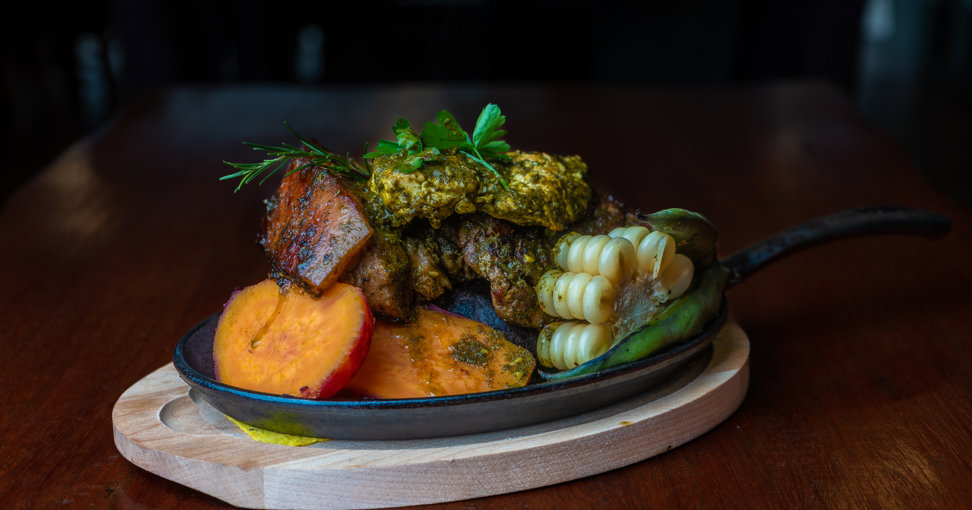Pachamanca: an ancient dish of the inkas

Pachamanca: an ancient dish of the Inkas
This feast originated in the Wari culture between the years 500 and 1,100 A.D. It is consumed throughout Peru, especially in the highlands of Ayacucho, Junín, Huancavelica, Huánuco, Ancash, and Cusco. It is traditionally cooked in the earth. Pachamanca is primarily prepared to commemorate various festivities. During the Inca period and the Viceroyalty, the ingredients increased, and it now includes beef, chicken, lamb, guinea pig, pork—all of which are partially boiled. Corn, potatoes, oca, sweet potato, humitas, and broad beans are also added, along with rocoto peppers, cheese, and salsa criolla, depending on the region.
The cooking process involves digging a hole in the ground with a shovel or another tool, placing hot stones or bricks heated by firewood or charcoal. Marinated meat wrapped in banana leaves is placed first, followed by the remaining ingredients, forming an oven-like structure. It is then left to cook for 40 to 90 minutes, depending on the quantity of ingredients.
Potato: the star of pachamanca
This dish starts with its main ingredient: the potato. This tuber was domesticated more than 7,000 years ago in the central Andes—especially in what are now Peru and Bolivia—and was a fundamental food for pre-Incan and Incan civilizations. Its high nutritional value and ability to adapt to various altitudes and climates made it the cornerstone of Andean diets.
The ancient Peruvians not only consumed potatoes boiled or roasted but also seasoned them with chili peppers and preserved them as chuño, an ancient dehydration technique that allowed them to store the food for months.
Today, Peru is the world leader in potato biodiversity. It is estimated that there are over 5,000 varieties worldwide, with at least 2,300 registered in Peru alone. This genetic wealth has been crucial for the development of a great diversity of preparations within Peruvian cuisine.
Foreign influence on local cuisine
With the arrival of the Spanish in the 16th century, and later during the Viceroyalty, peruvian cuisine began to transform. There was a fusion between native ingredients and European culinary techniques, mainly Spanish, which had in turn been influenced by Arab gastronomy after centuries of occupation on the Iberian Peninsula.
The use of oil for frying, the blending of spices, and the combination of meats with dried fruits like raisins are legacies that arrived in the Americas through this cultural mestizaje. Additionally, during the Viceroyalty, enslaved African workers, mostly women, were introduced, and they left a profound mark on Creole cuisine by adapting local products to their knowledge and customs.
RECIPE
(pachamanca in a pot)
Ingredients:
- 1 chopped red onion
- 500 g pork belly, in chunks
- 500 g chicken pieces
- 2 ½ teaspoons salt
- ¼ teaspoon pepper
- ¼ teaspoon cumin
- 4 tablespoons crushed garlic
- 4 tablespoons yellow chili paste
- 3 tablespoons panca chili paste
- 1 cup chincho leaves
- 1 cup huacatay leaves and two whole branches
- 4 tablespoons vegetable oil
- 16 whole fava beans with skin and unpeeled
- 4 small sweet potatoes (500 g)
- 4 huayro potatoes
- 2 ears of corn
- 16 corn husk leaves
- 1 peeled yuca, in chunks (optional)
Preparation:
In a bowl, mix 2 teaspoons salt, ¼ teaspoon pepper, ¼ teaspoon cumin, 2 tablespoons crushed garlic, 2 tablespoons panca chili paste, and 4 tablespoons yellow chili paste.
Place the meats in a dish and rub them with the seasoning mixture.
Blend the chincho leaves, huacatay leaves, 4 tablespoons oil, half a cup of water, and ½ teaspoon salt.
In a pot, heat the oil. Add the chopped onion, 2 tablespoons crushed garlic, and 1 tablespoon panca chili paste, and cook on low heat until golden. Then, mix in the blended herbs.
Rub the meats with this seasoning and let them rest for at least 2 hours or overnight in a dish.
In a pot, place a light layer of corn husks. Then, add the meats, skin side down. On top, add the potatoes, sweet potatoes, and yuca. Finally, add the fava beans and the corn.
Pour the remaining seasoning from the dish over the ingredients and cover with huacatay branches. Cover with corn husks and put the pot’s lid on.
Bring to high heat for 8 minutes, then lower the heat and cook for 1 hour.
Insert a wooden stick into the tubers to check that they are properly cooked.
If necessary, add half a cup of water during cooking to generate steam and prevent burning.
Serve the Pachamanca in a pot with chili sauce for a perfect combination.